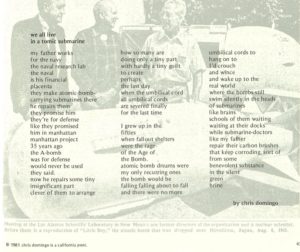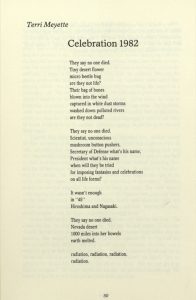
“we all live in a tomic submarine,” as printed in Heresies’s Special Environmental Issue “Earthkeeping/Earthshaking.”
In addition to advocating against the degradation of the natural environment via colonization, ecofeminists recognized that the military-industrial complex and its development of nuclear weapons would threaten life on earth as we know it. The poem “we all live in a tomic submarine” by Chris Domingo, published in Heresies’s Special Environmental issue in 1981, conveys the imminent potential for nuclear weaponry to extinguish the lives of every living, breathing organism inhabiting the earth.
In the beginning, the narrator articulates how her father was involved in the Manhattan Project, unaware of the cataclysmic implications of being involved in the mass genocide of Japanese civilians in the Nagasaki and Hiroshima bombings in World War II. The government falsely promised him that the weapons of mass destruction being developed were only “for defense” and that they would “never be used” (Domingo 43). Although his role in the Manhattan Project was “only a tiny part,” he will never be absolved of his guilt for the severing of all umbilical cords, the cords of life, for the last time. In the following stanza, the speaker describes how she grew up in the fifties, when “fallout shelters / were the rage / of the Age of / the Bomb” (43). In the wake of the advent of the atomic bomb, the deadliest weapon developed in the history of humanity, the specter of “atomic bomb dreams” haunted the collective conscious of Americans. Yet, even when she would wake up from the dream, she would wake up to the equally nightmarish real world, where the bombs still “swim silently in the heads / of submarines” (43). Nevertheless, submarine-doctors, like her father, continue to play a role in the expansion of the military-industrial complex, even though it threatens to sever all umbilical cords from the womb of life by “[repairing] their carbon brushes / that keep corroding” (43).

“Celebration 1982,” as printed in Sinister Wisdom’s Special Native American Issue.
Published in Sinister Wisdom’s Special Native American issue in 1983, Terri Meyette’s poem “Celebration 1982” also illustrates how patriarchal blood-rituals, such as war, are threatening the Anthropocene with extinction. Throughout the poem, the speaker implements anaphora by repeating the phrase “they say no one died”– “they” referring to the patriarchs that control the government and distort public perceptions regarding their involvement in wartime casualties. In the second stanza, the speaker brings up the culpability of scientists–the “unconscious mushroom button pushers”– for developing the technology to create nuclear weaponry, such as the atomic bomb deployed by the United States in World War II. However, the speaker also acknowledges that the government, namely the Secretary of Defense and the President, are the most at fault, for they are the warmongers ultimately responsible for funding this project of mass destruction and for dropping it upon millions of innocent civilians, and thus deserve to be “tried / for imposing fantasies and celebrations / on all life forms” (50).
For the warmongering patriarchs, it was not enough to bomb Hiroshima and Nagasaki in 1945, instantly extinguishing the lives of millions of souls– the Nevada desert and its nearby inhabitants were their next victims. Because the U.S. government used the barren Nevada desert, devoid of life, as a testing site for nuclear weaponry, they “say that no one died” (50). Nevertheless, the desert itself is anthropomorphized into a living organism, whose “bowels melted [1000 miles into the earth]” (50). Even if the Nevada desert was devoid of living beings, the radiation that ensued from the detonations on the testing site “oozed into blood / of Shoshone and Paiute,” irreversibly polluting the territories of Indigenous nations who occupy the Duck Valley Indian Reservation in Nevada in close proximity to the testing site. In fact, the Nevada test site itself is situated in the ancestral territory of the Shoshone and Pauite peoples. In 1951, the U.S. government appropriated the territory for the sole purpose of testing nuclear weapons, at the expense of the lives of Indigenous peoples. To politicians, saving a sacred area and preserving this archeological treasure was wholly irrelevant. With 814 nuclear tests having been completed to date, the Shoshone and Paiute nations are the most bombed nations on the planet.
Although the bomb itself lasted only minutes, the “intent lasts generations / in the womb of Creation, herself” (51). The radioactivity emanating from these detonations has contributed to a high concentration of cancerous diseases, such as leukemia, lymphoma, and melanoma, in the bordering reservations. The very survival of Indigenous peoples is at stake– they have no other gene pool in the world, and exposure to nuclear radiation and the ingestion of contaminants irreversibly mutate genes. These toxic compounds remain in the body, where they are passed on from the womb onto posterity decades after the testing of nuclear weapons in the site is halted. The Nevada test site remains radioactive to this day, making it impossible for Indigenous peoples to reclaim and return to their ancestral land, and the substantial radioactive fallout from the hundreds of detonations that have taken place since the 1950s has contaminated the womb of the earth herself, poisoning her offspring for generations to come.
Sources:
“A Gathering of Spirit: North American Indian Women’s Issue.” Sinister Wisdom, no. 22-23, January 1983.
Domingo, Chris. “we all live in a tomic submarine.” Heresies, vol. 4, no. 1, p. 43
“Earthkeeping/Earthshaking.” Heresies: A Feminist Publication on Arts and Politics, vol. 4, no. 1, July 1981.
Meyette, Terri. “Celebration 1982.” Sinister Wisdom, no. 22-23, pp. 50-51.
“Nuclear War: Uranium Mining and Nuclear Tests on Indigenous Lands.” Cultural Survival Quarterly Magazine, September 1993, https://www.culturalsurvival.org/publications/cultural-survival-quarterly/nuclear-war-uranium-mining-and-nuclear-tests-indigenous. Accessed 7 December 2021.
